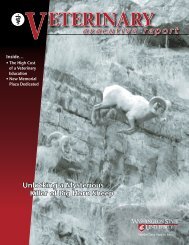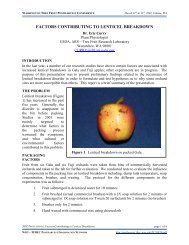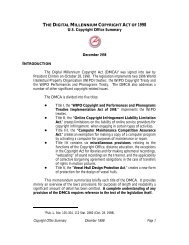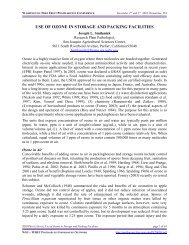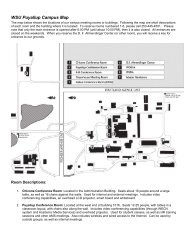bin sanitation: an effective way to reduce codling moth - Postharvest ...
bin sanitation: an effective way to reduce codling moth - Postharvest ...
bin sanitation: an effective way to reduce codling moth - Postharvest ...
Create successful ePaper yourself
Turn your PDF publications into a flip-book with our unique Google optimized e-Paper software.
WASHINGTON STATE UNIVERSITY—TREE FRUIT RESEARCH AND EXTENSION CENTERBIN SANITATION:AN EFFECTIVE WAY TO REDUCE CODLING MOTHAND FUNGAL DECAY SPORESJames H<strong>an</strong>sen, USDA-ARS Yakima;Ch<strong>an</strong>g-Lin Xiao, Washing<strong>to</strong>n State University, WenatcheeGene Kupferm<strong>an</strong>, Washing<strong>to</strong>n State University, WenatcheeA major challenge in <strong>codling</strong> <strong>moth</strong> m<strong>an</strong>agement is the reintroduction of <strong>moth</strong>s in empty <strong>bin</strong>scontaining overwintering (or diapausing) larvae. The scientific literature shows that as m<strong>an</strong>y astwelve <strong>codling</strong> <strong>moth</strong> adults c<strong>an</strong> emerge from a single wooden <strong>bin</strong>. If diapausing <strong>codling</strong> <strong>moth</strong>larvae could be eliminated from these containers, then control strategies would be more<strong>effective</strong>. Also, it is believed that <strong>bin</strong>s may recycle blue mold (Penicillium) spores between thepacking houses <strong>an</strong>d orchards, providing spores from affected fruit <strong>to</strong> inoculate other fruit duringthe packing process.V<strong>an</strong> Doren Sales <strong>an</strong>d Auvil Fruit Comp<strong>an</strong>y fabricated <strong>an</strong>d tested a new type of s<strong>an</strong>itizer for apple<strong>bin</strong>s designed <strong>to</strong> <strong>reduce</strong> the viability of both <strong>codling</strong> <strong>moth</strong> <strong>an</strong>d decay spores. The <strong>bin</strong> s<strong>an</strong>itizerheats water <strong>to</strong> 170 °F <strong>an</strong>d the <strong>bin</strong> is immersed for approximately 30 seconds. The system wasevaluated at Auvil Fruit Comp<strong>an</strong>y, Orondo, Washing<strong>to</strong>n, last spring by U.S. Department ofAgriculture—Agricultural Research Service en<strong>to</strong>mologist Jim H<strong>an</strong>sen <strong>an</strong>d Washing<strong>to</strong>n StateUniversity –Tree Fruit Research <strong>an</strong>d Extension Center pl<strong>an</strong>t pathologist Ch<strong>an</strong>g-Lin Xiao. Theresults are very promising.Hot water dips may be a suitable method for treating larvae-contaminated <strong>bin</strong>s. The effect of theheat need not be immediate. Heat-damaged larvae may not survive <strong>to</strong> become adults.This pho<strong>to</strong>graph shows the difference in the number of Penicillium sporessampled from plywood <strong>bin</strong>s before (left) <strong>an</strong>d after the s<strong>an</strong>itizing treatment.MAY 2010 ARTICLE, Bin S<strong>an</strong>itation page 1 of 3POSTHARVEST INFORMATION NETWORKhttp://postharvest.tfrec.wsu.edu/REP2010B.pdf
WASHINGTON STATE UNIVERSITY—TREE FRUIT RESEARCH AND EXTENSION CENTERMortality RatesAt the Yakima Agricultural Research Labora<strong>to</strong>ry in Wapa<strong>to</strong>, Washing<strong>to</strong>n, H<strong>an</strong>sen conducted aseries of tests <strong>to</strong> determine the mortality rates of diapausing larvae due <strong>to</strong> heat. All larvae werekilled when submerged in water heated above 122 °F. However, because diapausing larvaefrequently overwinter in cracks <strong>an</strong>d corners of wooden <strong>bin</strong>s, treatment efficacy was determinedby simulating this environment by placing the cardboard strips containing diapausing larvaebetween two wooden strips. Fewer th<strong>an</strong> 16% of the larvae survived <strong>to</strong> adults when these woodens<strong>an</strong>dwiches were dipped in<strong>to</strong> 176 °F water for 30 seconds. This provided a target temperature fora potential <strong>bin</strong> treatment.Efficacy tests were conducted at Auvil Fruit Comp<strong>an</strong>y using a unit built by V<strong>an</strong> Doren Sales forsterilizing wooden <strong>bin</strong>s. Diapausing larvae in wooden s<strong>an</strong>dwiches were held in sleeves attached<strong>to</strong> three locations inside empty <strong>bin</strong>s: <strong>to</strong>p, middle, <strong>an</strong>d bot<strong>to</strong>m. The <strong>bin</strong>s moved along a track,submerged for 20 seconds in a 176 °F water bath within <strong>an</strong> enclosed structure, <strong>an</strong>d then emergedon <strong>an</strong> open track, taking about 2.5 minutes <strong>to</strong> complete the cycle. When the larvae were allowed<strong>to</strong> continue development in the lab, only one adult emerged from among the 662 treated larvae,which represents 99.8% chronic efficacy.This packing house demonstration clearly showed that diapausing <strong>codling</strong> <strong>moth</strong> larvae c<strong>an</strong> bequickly controlled while residing in empty <strong>bin</strong>s. The wooden <strong>bin</strong>s hold heat after they leave thebath, which extended the actual treatment time. The treatment enclosure also retained heat,which further aids in the process, <strong>an</strong>d the actual exposure was extended because of the time ittakes <strong>to</strong> move the <strong>bin</strong>s.Blue MoldBlue mold, caused by Penicillium spp., primarily P. exp<strong>an</strong>sum, is a major postharvest disease onapples <strong>an</strong>d pears. Because this fungus has developed resist<strong>an</strong>ce <strong>to</strong> thiabendazole (TBZ, Mertect),the product often fails <strong>to</strong> control blue mold when it is applied as a pres<strong>to</strong>rage drench or on-linespray during packing. Resist<strong>an</strong>t strains of P. exp<strong>an</strong>sum develop on decayed fruit during s<strong>to</strong>ragein the packing houses. Thus, it is necessary <strong>to</strong> s<strong>an</strong>itize <strong>bin</strong>s before they are returned <strong>to</strong> theorchards.Two tests were conducted at Auvil Fruit Comp<strong>an</strong>y <strong>to</strong> evaluate the <strong>effective</strong>ness of the hot waterdiptreatment in s<strong>an</strong>itizing <strong>bin</strong>s, particularly in eliminating spores of Penicillium spp. The firsttest was conducted using commercial wooden <strong>bin</strong>s. Five replicate <strong>bin</strong>s were wet prior <strong>to</strong> the hotwater treatment. Three 8 x 8 cm areas on each replicate <strong>bin</strong> were swabbed with cot<strong>to</strong>n Q-Tipsbefore <strong>an</strong>d after the hot water treatment. The Q-tips were placed in sterile water <strong>to</strong> make solutionsamples, which were then plated on <strong>an</strong> agar medium in the labora<strong>to</strong>ry <strong>to</strong> qu<strong>an</strong>tify spore numbers.After about a 20-second immersion of <strong>bin</strong>s in the hot water, the spore load on the <strong>bin</strong> surface was<strong>reduce</strong>d by 89%.In the second test, pieces of plywood (each 2 x 2 cm) were inoculated with P. exp<strong>an</strong>sum sevendays before the test. Plywood pieces with abund<strong>an</strong>t spores of P. exp<strong>an</strong>sum were placed in meshbags <strong>an</strong>d stapled on the <strong>bin</strong>s. Bins were then subjected <strong>to</strong> the hot water dip treatment.Approximately 99.9% of the spores on plywood pieces were killed after the hot water treatment.The test results indicated that the hot water dips killed the majority of Penicillium spores on thesurfaces of wooden <strong>bin</strong>s, though it did not completely sterilize <strong>bin</strong>s.Our tests demonstrated that the hot water dips were beneficial in eliminating both <strong>codling</strong> <strong>moth</strong>larvae <strong>an</strong>d Penicillium spores from <strong>bin</strong>s. Although tests were not performed on plastic <strong>bin</strong>s, it isMAY 2010 ARTICLE, Bin S<strong>an</strong>itation page 2 of 3POSTHARVEST INFORMATION NETWORKhttp://postharvest.tfrec.wsu.edu/REP2010B.pdf
WASHINGTON STATE UNIVERSITY—TREE FRUIT RESEARCH AND EXTENSION CENTERknown that <strong>codling</strong> <strong>moth</strong> will overwinter in plastic as well as wooden <strong>bin</strong>s. A question wasraised about the ability of plastic <strong>bin</strong>s <strong>to</strong> withst<strong>an</strong>d the heat of the drench. Joe Johnson, technicalservices m<strong>an</strong>ager for Macro Plastics, stated:The immersion of empty MacroBins in 170 °F water for three <strong>to</strong> four minutes will notdamage our <strong>bin</strong>s.Funding was provided by WSU <strong>an</strong>d USDA. The cooperation of Walt Hough <strong>an</strong>d Auvil FruitComp<strong>an</strong>y is acknowledged.MAY 2010 ARTICLE, Bin S<strong>an</strong>itation page 3 of 3POSTHARVEST INFORMATION NETWORKhttp://postharvest.tfrec.wsu.edu/REP2010B.pdf


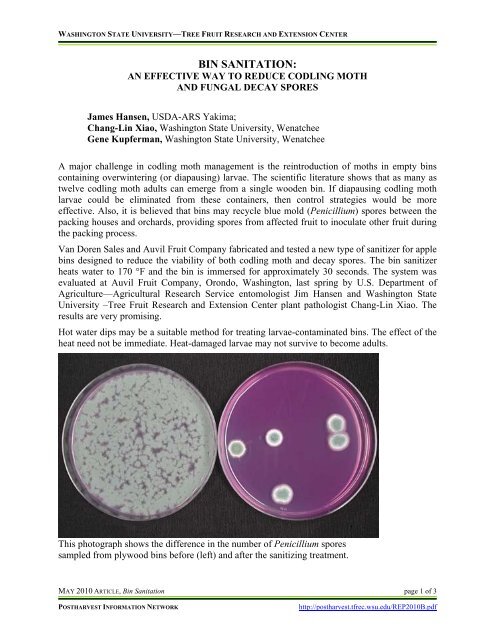
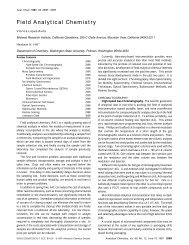
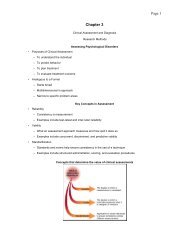


![Graduate School Policies & Procedures Manual 2011 - 2012 [PDF]](https://img.yumpu.com/50747405/1/190x245/graduate-school-policies-procedures-manual-2011-2012-pdf.jpg?quality=85)
